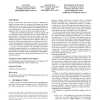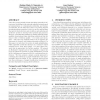173 search results - page 30 / 35 » Learning to rank networked entities |
KDD
2009
ACM
14 years 8 months ago
2009
ACM
In large social networks, nodes (users, entities) are influenced by others for various reasons. For example, the colleagues have strong influence on one's work, while the fri...
KDD
2009
ACM
14 years 2 months ago
2009
ACM
There is a growing wealth of data describing networks of various types, including social networks, physical networks such as transportation or communication networks, and biologic...
WWW
2004
ACM
14 years 8 months ago
2004
ACM
We present a question answering (QA) system which learns how to detect and rank answer passages by analyzing questions and their answers (QA pairs) provided as training data. We b...
IJCNN
2006
IEEE
14 years 1 months ago
2006
IEEE
Abstract— While the model parameters of many kernel learning methods are given by the solution of a convex optimisation problem, the selection of good values for the kernel and r...
AI
2008
Springer
13 years 6 months ago
2008
Springer
Although classical first-order logic is the de facto standard logical foundation for artificial intelligence, the lack of a built-in, semantically grounded capability for reasonin...


